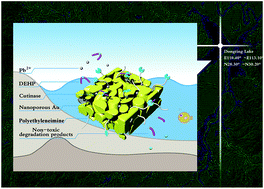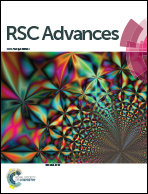Combined removal of di(2-ethylhexyl)phthalate (DEHP) and Pb(ii) by using a cutinase loaded nanoporous gold-polyethyleneimine adsorbent†
Abstract
A cutinase loaded nanoporous gold-polyethyleneimine (NPG-PEI) was fabricated for the application in simultaneous removal of DEHP and Pb(II) from contaminated water. The thermal stability, acid and alkali resistance, storage stability and reutilization of immobilized cutinase were enhanced. The removal kinetics of DEHP and Pb(II) were described by a pseudo-second-order kinetic model, and the adsorption isotherms for Pb(II) were fitted by a Langmuir model. Pb(II) had a suppression effect on DEHP uptake in the simultaneous removal and DEHP preloading experiments. The overall DEHP removal efficiency was about 90.9%, in which enzymatic hydrolysis contributed about 81.9%, and the enzymatic degradation products of DEHP were mainly non-toxic 1,3-isobenzofurandione (IBF). In simultaneous removal of DEHP and Pb(II) at low concentrations, the cutinase loaded NPG-PEI can be used more than five times before regeneration. Due to its high removal capacity, easy separation and effective reusability, cutinase loaded NPG-PEI presented excellent potential in wastewater treatment.


 Please wait while we load your content...
Please wait while we load your content...